Sippar
Sippar (Sumerian: 𒌓𒄒𒉣𒆠, Zimbir) was an ancient Near Eastern Sumerian and later Babylonian city on the east bank of the Euphrates river. Its tell is located at the site of modern Tell Abu Habbah near Yusufiyah in Iraq's Baghdad Governorate, some 69 km (43 mi) north of Babylon and 30 km (19 mi) southwest of Baghdad. The city's ancient name, Sippar, could also refer to its sister city, Sippar-Amnanum (located at the modern site of Tell ed-Der); a more specific designation for the city here referred to as Sippar was Sippar-Yahrurum.[1]
Sippar | |
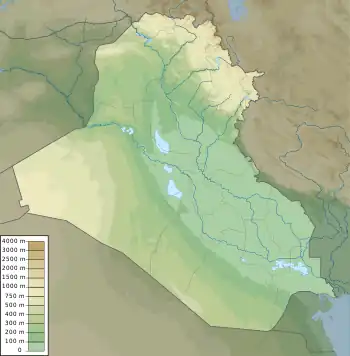 Shown within Iraq | |
| Location | Baghdad Governorate, Iraq |
|---|---|
| Region | Mesopotamia |
| Coordinates | 33°03′32″N 44°15′08″E |
| Type | tell |
| History | |
| Periods | Early Dynastic, Old Babylonian, Neo-Babylonian |
History

Despite the fact that thousands of cuneiform clay tablets have been recovered at the site, relatively little is known about the history of Sippar. As was often the case in Mesopotamia, it was part of a pair of cities, separated by a river. Sippar was on the east side of the Euphrates, while its sister city, Sippar-Amnanum (modern Tell ed-Der), was on the west.

While pottery finds indicate that the site of Sippar was in use as early as the Uruk period, substantial occupation occurred only in the Early Dynastic Period of the 3rd millennium BC, the Old Babylonian period of the 2nd millennium BC, and the Neo-Babylonian time of the 1st millennium BC. Lesser levels of use continued into the time of the Achaemenid, Seleucid and Parthian Empires.[2]
Sippar was the cult site of the sun god (Sumerian Utu, Akkadian Shamash) and the home of his temple E-babbara (𒂍𒌓𒌓𒊏, means "white house").
During early Babylonian dynasties, Sippar was the production center of wool. The Code of Hammurabi stele was probably erected at Sippar. Shamash was the god of justice, and he is depicted handing authority to the king in the image at the top of the stele.[3] A closely related motif occurs on some cylinder seals of the Old Babylonian period.[4] By the end of the 19th century BC, Sippar was producing some of the finest Old Babylonian cylinder seals.[5]
Sippar has been suggested as the location of the Biblical Sepharvaim in the Old Testament, which alludes to the two parts of the city in its dual form.[6]
Rulers
In the Sumerian king list a king of Sippar, En-men-dur-ana, is listed as one of the early pre-dynastic rulers of the region but has not yet turned up in the epigraphic records.
In his 29th year of reign Sumu-la-El of Babylon reported building the city wall of Sippar. Some years later Hammurabi of Babylon reported laying the foundations of the city wall of Sippar in his 23rd year and worked on the wall again in his 43rd year. His successor in Babylon, Samsu-iluna worked on Sippar's wall in his 1st year. The city walls, being typically made of mud bricks, required much attention. Records of Nebuchadnezzar II and Nabonidos record that they repaired the Shamash temple E-babbara.
Classical speculation
Xisuthros, the "Chaldean Noah" in Sumerian mythology, is said by Berossus to have buried the records of the antediluvian world here—possibly because the name of Sippar was supposed to be connected with sipru, "a writing".[7] And according to Abydenus, Nebuchadnezzar II excavated a great reservoir in the neighbourhood.[8]
Pliny (Natural History 6.30.123) mentions a sect of Chaldeans called the Hippareni. It is often assumed that this name refers to Sippar (especially because the other two schools mentioned seem to be named after cities as well: the Orcheni after Uruk, and the Borsippeni after Borsippa), but this is not universally accepted.[9]
Archaeology
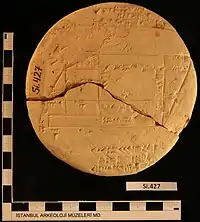
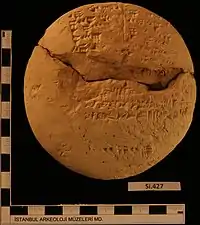
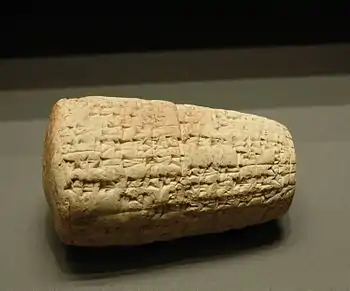
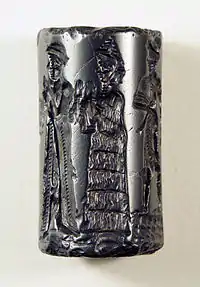
Tell Abu Habba, measuring over 1 square kilometer was first excavated by Hormuzd Rassam between 1880 and 1881 for the British Museum in a dig that lasted 18 months.[13] Tens of thousands of tablets were recovered including the Tablet of Shamash in the Temple of Shamash/Utu. Most of the tablets were Neo-Babylonian.[14][15] The temple had been mentioned as early as the 18th year of Samsu-iluna of Babylon, who reported restoring "Ebabbar, the temple of Szamasz in Sippar", along with the city's ziggurat.
The tablets, which ended up in the British Museum, are being studied to this day.[16] As was often the case in the early days of archaeology, excavation records were not made, particularly find spots. This makes it difficult to tell which tablets came from Sippar-Amnanum as opposed to Sippar.[17] Other tablets from Sippar were bought on the open market during that time and ended up at places like the British Museum and the University of Pennsylvania.[18][19] Since the site is relatively close to Baghdad, it was a popular target for illegal excavations.[20]
In 1894, Sippar was worked briefly by Jean-Vincent Scheil.[21] The tablets recovered, mainly Old Babylonian, went to the Istanbul Museum.[22] In modern times, the site was worked by a Belgian team from 1972 to 1973.[23] Iraqi archaeologists from the College of Arts at the University of Baghdad, led by Walid al-Jadir with Farouk al-Rawi, have excavated at Tell Abu Habbah from 1977 through the present in 24 seasons.[24][25][26] In the 8th season a library of over 300 tablets was discovered but few were published at the time due to conditions in Iraq. With conditions improving they are now being published.[27][28][29] After 2000, they were joined by the German Archaeological Institute.[30][31] According to Andrew George, a cuneiform tablet containing a portion of the Epic of Gilgamesh probably came from Sippar.[32]
In Sippar was the site where the Babylonian Map of the World was found.
Gallery
 Map of the World from Sippar, Mesopotamia, Iraq. 6th century BCE. The British Museum
Map of the World from Sippar, Mesopotamia, Iraq. 6th century BCE. The British Museum Tablet of Nabu-apla-iddina, 9th century BCE, from Sippar, Iraq. British Museum
Tablet of Nabu-apla-iddina, 9th century BCE, from Sippar, Iraq. British Museum Detail, Sun God Tablet from Sippar, Iraq, 9th century BCE. British Museum
Detail, Sun God Tablet from Sippar, Iraq, 9th century BCE. British Museum Detail, Kudurru of Ritti-Marduk, from Sippar, Iraq, 1125-1104 BCE. British Museum
Detail, Kudurru of Ritti-Marduk, from Sippar, Iraq, 1125-1104 BCE. British Museum
Notes
- "Sippar". The Oxford Encyclopedia of Archaeology in the Near East (1 ed.). Oxford University Press. 1997-01-01. doi:10.1093/acref/9780195065121.001.0001. ISBN 978-0-19-506512-1.
- MacGinnis, John, Jon McGinnis, and Cornelia Wunsch. The arrows of the sun: armed forces in Sippar in the first millennium BC. Islet-Verlag, 2012 ISBN 9783980846653
- "Law Code of Hammurabi, king of Babylon" , Louvre, retrieved on 29 Nov 2013.
- British Museum. Department of Western Asiatic Antiquities (1962). Catalogue of the Western Asiatic seals in the British Museum. D. J. Wiseman, Dominique Collon, Edith Porada, Parvine H. Merrillees, T. C. Mitchell, A. D. H. Bivar. London: Trustees of the British Museum. ISBN 0-7141-1104-X. OCLC 329699.
- Collon, Dominique (2005). First impressions : cylinder seals in the ancient Near East ([Rev. ed.] ed.). London: British Museum Press. ISBN 0-7141-1136-8. OCLC 63186269.
- G. R. Driver, Geographical Problems, Eretz Israel, vol. 5, pp. 18-20, 1958
- Ward, William Hayes, "Sippara", Hebraica, vol. 2, no. 2, pp. 79–86, 1886
- Dalley, Stephanie, "Nineveh, Babylon and the Hanging Gardens: Cuneiform and Classical Sources Reconciled", Iraq, vol. 56, pp. 45–58, 1994
- "It is usually assumed that the Hippareni refers to Sippar (Ptolemy's Sippara), but even that requires proof, since the change of ‘s’ to ‘h’ is strange." —R. D. Barnett (1963). "Xenophon and the Wall of Media". The Journal of Hellenic Studies. The Journal of Hellenic Studies, Vol. 83. 83: 1–26. doi:10.2307/628451. JSTOR 628451. S2CID 163366720.
- Mansfield, Daniel F. (January 2020). "Perpendicular Lines and Diagonal Triples in Old Babylonian Surveying". Journal of Cuneiform Studies. 72: 87–99. doi:10.1086/709309. S2CID 224837017.
- Beek, Martinus Adrianus (1973). Symbolae Biblicae Et Mesopotamicae Francisco Mario Theodoro de Liagre Böhl Dedicatae. Brill Publishers. p. 379.
- Al-Gailani Werr, L., 1988. Studies in the chronology and regional style of Old Babylonian Cylinder Seals. Bibliotheca Mesopotamica, Volume 23.
- Hormuzd Rassam, Asshur and the Land of Nimrod: Being an Account of the Discoveries Made in the Ancient Ruins of Nineveh, Asshur, Sepharvaim, Calah, [etc]..., Curts & Jennings, 1897
- British Museum. Department of Western Asiatic Antiquities. Catalogue of the Babylonian tablets in the British Museum. H. H. Figulla, Marcel Sigrist, C. B. F. Walker, Ran Zadok, Erle Leichty, Irving L. Finkel. [London]. ISBN 0-7141-1139-2. OCLC 2581635.
- Erie Leichty et al., Catalogue of the Babylonian Tablets in the British Museum: Tablets from Sippar 3, vol. 8, British Museum Publications, 1988, ISBN 0-7141-1124-4
- Nebo-Sarsekim Cuneiform Tablet at Archaeology.org
- Goddeeris, Anne (2002). Economy and society in northern Babylonia in the early old Babylonian period (ca. 2000-1800 BC). Leuven: Peeters. ISBN 90-429-1123-9. OCLC 50207588.
- Hermann Ranke, Babylonian Legal and Business Documents from the Time of the First Dynasty of Babylon; Chiefly from Sippar, University of Pennsylvania, 1906 (reprinted by Nabu Press ISBN 1-144-69277-6)
- Lerberghe, Karel van (1986). Old Babylonian legal and administrative texts from Philadelphia. Marten Stol, Gabriela Voet. Leuven: Departement Oriëntalistiek. ISBN 90-6831-063-1. OCLC 18962321.
- E. A. Budge, By Nile and Tigris: A Narrative of Journeys in Egypt and Mesopotamia on Behalf of the British Museum Between the Years 1886 and 1913, John Murray, 1920
- V. Scheil, Une Saison de fouilles a Sippar, Le Caire, 1902
- Adalı, Selim Ferruh, and Frahm Eckart, "The Slave-Girl's Child: A" Literary" Fragment from the Istanbul Sippar Archive", Aula Orientalis, pp. 5-17, 2021
- Tell ed-Dēr : sounding at Abū Ḥabbah (Sippar). Leon de Meyer. Leeuven: Peeters. 1980. ISBN 2-8017-0160-2. OCLC 8165805.
{{cite book}}: CS1 maint: others (link) - Lamia al-Gailani and Walid al-Jadir, Seal Impressions from Sippar, Sumer, vol. 37, pp. 129-144, 1981
- Al-Rawi, Farouk N. H. (2000). Old Babylonian texts from private houses at Abu Habbah ancient Sippir : Baghdad University excavations. Stephanie Dalley. London: NABU. ISBN 1-897750-07-2. OCLC 47677571.
- W. al-Jadir and Z. Rajib, "Archaeological Results from the Eighth Season at Sippar", Sumer, vol. 46, pp. 69-90, 1990 (in arabic)
- Fadhil, Anmar Abdulillah, and Enrique Jiménez, "Literary Texts from the Sippar Library I: Two Babylonian Classics", Zeitschrift für Assyriologie und vorderasiatische Archäologie 109.2, pp. 155-176, 2019
- Fadhil, Anmar Abdulillah, and Enrique Jiménez, "Literary Texts from the Sippar Library II: The Epic of Creation", Zeitschrift für Assyriologie und vorderasiatische Archäologie 111.2, pp. 191-230, 2021
- Fadhil, Anmar Abdulillah, and Enrique Jiménez, "Literary Texts from the Sippar Library III:‘Eriš šummi’, a Syncretistic Hymn to Marduk", Zeitschrift für Assyriologie und vorderasiatische Archäologie 112.2, pp. 229-274, 2022
- Abdulillah Fadhil et al., Ausgrabungen in Sippar (Tell Abu Habbah). Vorbericht über die Grabungsergebnisse der 24. Kampagne 2002, in: Baghdader Mitteilungen (BaM) 36, pp. 157-224, 2005
- Abdulillah Fadhil et. el., Sippar - Results of prospecting 2004/24, in: Sumer, A journal of archaeology in Iraq and the Arab world, vol. LII, no. 1&2, pp. 294-357, 2004
- The Babylonian Gilgamesh epic : introduction, critical edition and cuneiform texts. A. R. George. Oxford: Oxford University Press. 2003. p. 172. ISBN 0-19-814922-0. OCLC 51668477.
{{cite book}}: CS1 maint: others (link)
Further reading
- Rivkah Harris, Ancient Sippar : a demographic study of an old-Babylonian city, 1894-1595 B.C., Nederlands Historisch-Archaeologisch Instituut, 1975
- F. N. H. al-Rawi, Tablets from the Sippar Library I. The "Weidner Chronicle": A Suppositious Royal Letter concerning a Vision, Iraq, vol. 52, pp. 1–15, 1990
- F. N. H. al-Rawi and A. R. George, Tablets from the Sippar Library II. Tablet II of the Babylonian Creation Epic, Iraq, vol. 52, pp. 149–158, 1990
- F. N. H. al-Rawi and A. R. George, Tablets from the Sippar Library III. Two Royal Counterfeits, Iraq, vol. 56, pp. 135–149, 1994
- Luc Dekier, Old Babylonian real estate documents from Sippar in the British Museum, University of Ghent, 1994
- F. N. H. al-Rawi and A. R. George, Tablets from the Sippar Library IV. Lugale, Iraq, vol. 57, pp. 199–224, 1995
- John MacGinnis, Letter orders from Sippar and the administration of the Ebabbara in the late-Babylonian period, Bonami, 1995, ISBN 83-85274-07-3
- F. N. H. al-Rawi and A. R. George, Tablets from the Sippar Library V. An Incantation from Mis Pi, Iraq, vol. 57, pp. 225–228, 1995
- F. N. H. Al-Rawi and Andrew George, Tablets from the Sippar Library, VI. Atra-hasis, Iraq, vol. 58, pp. 147–190, 1996
- A. C. V. M. Bongenaar, The Neo-Babylonian Ebabbar Temple at Sippar : its administration and its prosopography, Nederlands Historisch-Archeologisch Instituut te Istanbul, 1997, ISBN 90-6258-081-5
- F. N. H. al-Rawi and A. R. George, Tablets from the Sippar Library VII. Three wisdom texts, Iraq, vol. 60, pp. 187–206, 1998
- Ivan Starr and F. N. H. Al-Rawi, Tablets from the Sippar Library VIII. Omens from the Gall-Bladder, Iraq, vol. 61, pp. 173–185, 1999
- W. Horowitz and F. N. H. Al-Rawi , Tablets from the Sippar library IX. A ziqpu-star planisphere, Iraq, vol. 63, pp. 171–181, 2001
- F. N. H. al-Rawi, Tablets from the Sippar library X: A dedication of Zabaya of Larsa, Iraq, vol. 64, pp. 247–248, 2002
- Andrew George and Khalid Salim Ismail, Tablets from the Sippar library, XI. The Babylonian almanac, Iraq, vol. 64, pp. 249–258, 2002
- Nils P. Heeßel and Farouk N. H. Al-Rawi, Tablets from the Sippar Library XII. A Medical Therapeutic Text, Iraq, vol. 65 , pp. 221–239, 2003
- F. N. H. Al-Rawi and A. R. George, Tablets from the Sippar Library XIII: "Enūma Anu Ellil" XX, Iraq, vol. 68, pp. 23–57, 2006
- Moore, Stephen A., "Ransom and Quittance in Early Old Babylonian Sippar: a New Text", Revue d’assyriologie et d’archéologie orientale 116.1, pp. 69-78, 2022
- Theophilus Goldridge Pinches, The Antiquities found by Mr. H. Rassam at Abu-habbah (Sippara), Harrison and Sons, 1884
- K. De Graef, “Many a mickle makes a muckle : advance payments in the Ur-Utu archive (Old Babylonian Sippar),” AKKADICA, vol. 137, no. 1, pp. 1–51, 2016
- Janssen, Caroline, "Thirteen bones and a skeleton: the location of Inanna-mansum’s grave and material manifestations of the cult of the dead in Old Babylonian Sippar", Akkadica 143, pp. 59-100, 2022
- Reinhard Pirngruber, Minor Archives from First-Millennium Bce Babylonia: The Archive of Iššar-Tarībi from Sippar, Journal of Cuneiform Studies, vol. 72, pp. 165–198, 2020
- Richardson, Seth, "Hard Times for Sippar Women: Three Late Old Babylonian Cases", Journal of Ancient Near Eastern History 9.2, pp. 319-350, 2022
- Verhulst, Astrid. “An Old Babylonian Seal from Sippar with Trading Owners.” Journal of Near Eastern Studies, vol. 74, no. 2, 2015, pp. 255–65